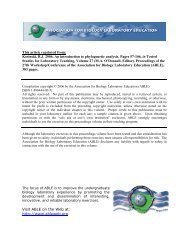A Study of Gene Linkage and Mapping Using - Association for ...
A Study of Gene Linkage and Mapping Using - Association for ...
A Study of Gene Linkage and Mapping Using - Association for ...
You also want an ePaper? Increase the reach of your titles
YUMPU automatically turns print PDFs into web optimized ePapers that Google loves.
18 Tetrad Analysis<br />
2. Complete Table 1.3 using the class data assembled from individual Tables 1.1.<br />
3. To estimate the map locations <strong>of</strong> the two genes, whether unlinked or linked, simply determine<br />
the total number <strong>of</strong> recombinant spores <strong>for</strong> each gene <strong>and</strong> divide by total spores observed (see<br />
study question 2). Note: A check on your computations would be to ascertain that total spores<br />
observed <strong>for</strong> both genes (non-recombinant spores + recombinant spores) is the same number.<br />
Comparison with Published Map Locations<br />
Published gene-centromere map locations <strong>for</strong> the two genes are approximately 27 map units <strong>for</strong><br />
the tan spore gene <strong>and</strong> 33 map units <strong>for</strong> the gray spore gene (Olive, 1956). You should use the chi<br />
square test to determine if your estimated map locations differ significantly from these values.<br />
Since map units are really the percent <strong>of</strong> all the spores that are recombinant spores, you might be<br />
inclined to use non-recombinant spores <strong>and</strong> recombinant spores as the categories in the chi square<br />
test. However, since the observed values in your chi square categories represent your sample size,<br />
you need to select categories that accurately reflect the amount <strong>of</strong> in<strong>for</strong>mation you have collected.<br />
Since the number <strong>of</strong> spores, whether non-recombinant or recombinant, is really a function <strong>of</strong> the<br />
number <strong>of</strong> asci you observed, you must use crossover <strong>and</strong> non-crossover asci as categories in the<br />
test. So, <strong>for</strong> example, if a gene is 27 map units from its centromere, recognizing that each crossover<br />
produces one-half recombinant <strong>and</strong> one-half non-recombinant spores, you would expect 54%<br />
crossover asci <strong>and</strong> 46% non-crossover asci . Your observed values will be the actual number <strong>of</strong><br />
crossover asci <strong>and</strong> non-crossover asci <strong>for</strong> that gene. The expected values would be the total number<br />
<strong>of</strong> asci seen by the class times 0.54 <strong>for</strong> the expected crossover asci <strong>and</strong> times 0.46 <strong>for</strong> the expected<br />
non-crossover asci (see study question 3).<br />
� Complete Table 1.4 using the class data assembled from individual Tables 1.1.<br />
Table 1.2. Class data showing the number <strong>of</strong> Parental Ditype (PD),<br />
Non-Parental Ditype (NPD), <strong>and</strong> Tetratype (T) asci from a genetic cross<br />
between the tan <strong>and</strong> gray spore strains <strong>of</strong> Sordaria fimicola .<br />
Ascus type<br />
Parental Ditype (PD)<br />
Non-Parental Ditype (NPD)<br />
Tetratype (T)<br />
Number counted<br />
Table 1.3. Class data showing recombinant <strong>and</strong> non-recombinant spores<br />
<strong>for</strong> the tan <strong>and</strong> gray spore genes <strong>of</strong> Sordaria fimicola from a genetic cross<br />
between the two mutant strains.<br />
Spores<br />
Recombinant<br />
Non-recombinant<br />
Total<br />
Gray Spore <strong>Gene</strong><br />
Tan Spore <strong>Gene</strong>
















